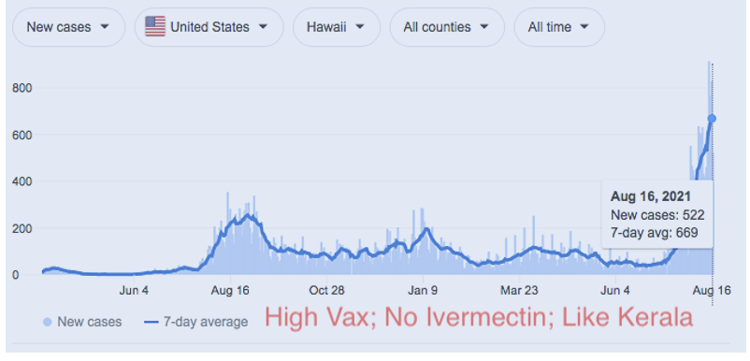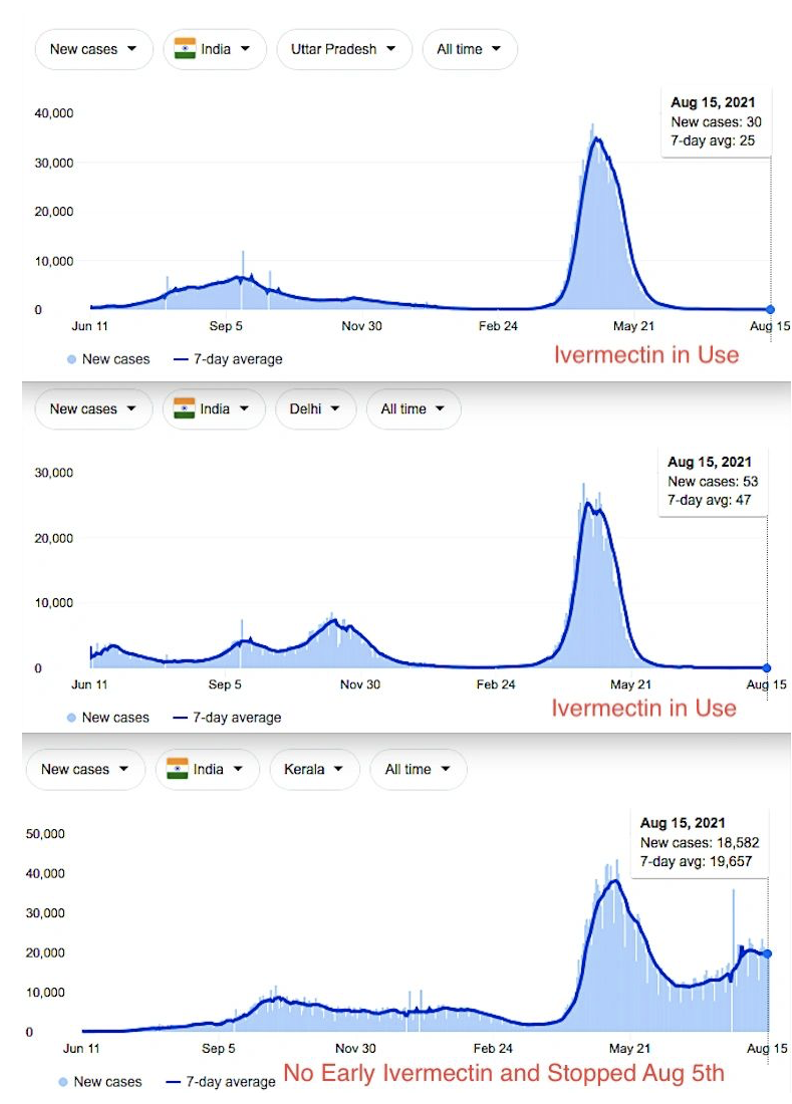Post by Panama pfRedd on Sept 26, 2021 19:27:52 GMT -5
India's Ivermectin Blackout - Part III: The Lesson of Kerala
The New York Times reported India’s colossal drop in COVID cases was unexplainable, while the BBC declared that Kerala’s rise was also a mystery. While new cases of COVID in Uttar Pradesh are rare as million-dollar lottery tickets, in Kerala, a tiny state located in southern India, new daily cases are the same as the United States, nearly one case per thousand. Yet, as we have seen in this series, there has been a curious media blackout on India’s overall success against COVID.
www.bbc.com/news/world-asia-india-58054124
www.nytimes.com/2021/0...delta-mysteries.html
"Kerala has been reporting over 22,000 new COVID infections in the last three days. No other state in India is even close to the 10,000 mark. The COVID conundrum in the southern state has led to several questions, with no certain answers."
The Times of India published this statement on July 29. Kerala has continued to have the majority of new daily cases and almost 25% of India's daily deaths despite a population of 34 million, less than 3% of India's total population.
On August 15, Kerala accounted for 18,582 of India's 32,937 new cases and 102 of India's 417 new deaths. By contrast, the Ivermectin-using state of Delhi, with nearly the same population size, recorded only 53 new cases and ZERO deaths. In comparison, Uttar Pradesh, with almost eight times as many inhabitants, had only 30 new cases and ONE death.
Kerala had 619 times as many new cases as Uttar Pradesh and over 100 times as many deaths.
So what could Kerala be doing wrong?
Hint: Over-reliance on vaccines and under-reliance on Ivermectin.
Uttar Pradesh led India in its use and has done even better than Delhi because they use Ivermectin early and preventatively.
"Uttar Pradesh was the first state in the country to introduce large-scale prophylactic and therapeutic use of Ivermectin. In May-June 2020, a team at Agra led by Dr. Anshul Pareek, administered Ivermectin to all RRT team members in the district on an experimental basis. It was observed that NONE OF THEM developed COVID-19 despite being in daily contact with patients who had tested positive for the virus," Uttar Pradesh State Surveillance Officer Vikssendu Agrawal said.
indianexpress.com/arti...-deaths-low-7311786/
Uttar Pradesh has a policy of treating ALL the contacts of an infected patient prophylactically with Ivermectin. In other words, in Uttar Pradesh, everyone in the house gets Ivermectin treatment even if only one is infected. Ivermectin is known to reduce mortality in infected and dramatically lowers the viral load, thereby helping reduce the spread of the virus to others.
www.medrxiv.org/conten...5.31.21258081v1.full
Dr. Tess Lawrie discussed the Ivermectin-related reduction in viral load and reduced transmissibility.
journals.lww.com/ameri..._treatment_of.7.aspx
Tamil Nadu rejected India's Ivermectin protocol on May 14 in favor of Remdesivir and mirrored our U.S. FDA policy. The U.S. also reflected Tamil Nadu’s dismal results.
To be clear, on April 22, the All India Institute of Medical Science (AIIMS) and the Indian Council of Medical Research (ICMR) added Ivermectin to the protocol as an option for the early treatment – even in mild cases – of COVID-19.
www.indiatoday.in/coro...9-1794038-2021-04-22
www.amazon.com/Ivermec...R-Hope/dp/1737415909
This guideline was updated May 17, 2021, and continues to incorporate Ivermectin, although some states like Tamil Nadu and Kerala have chosen NOT to adopt this Ivermectin protocol – much to their detriment.
covid.aiims.edu/clinic...t-covid-19-patients/
Despite a widespread attempt by the media and WHO to convince the world that India has dropped Ivermectin by citing the DGHS, the ICMR and AIIMS have not changed their position, and Ivermectin remains in the India National Protocol.
m.economictimes.com/in...cleshow/83321687.cms
While Kerala included Ivermectin in their state’s guideline in April, they restricted it’s use to only in Class B - severe cases or those with associated disease, making its use much less than if mild cases were allowed. This meant it was reserved as a late treatment if used at all.
health.kerala.gov.in/p...delines_apr_2021.pdf
Finally, Kerala abandoned Ivermectin use altogether on August 5, 2021.
health.kerala.gov.in/p...ines_V4_August_5.pdf
Juan Chamie, the Cambridge-based data analyst who has provided graphical insight and published on COVID, provided his answer to why Kerala's COVID cases have spun out of control.
"My main current explanation is the lack of early treatment. Kerala’s COVID protocol from April 2021 included Ivermectin, but not as an early treatment. As a result, only a small group qualified, those in Category B patients having high-risk factors. The new protocol from August 5 is even worse. They removed Ivermectin (completely)."
Another factor, according to Juan, was poor contact tracing. In addition, according to an Indian Governmental Audit, FAMILY TRANSMISSION was a significant problem.
www.thehindu.com/news/.../article35860715.ece
The Hindu reported on August 11, 2021, stated, "In districts such as Malappuram and Kozhikode, where the family size is huge and joint families are the norm, the transmission was spreading within families leading to a high test positivity rate."
Juan Chamie added this about the test positivity rate, “If you look at the test positivity rate of Kerala, it declined from over 25% to 10% and remained stable around it. Since the last protocol change that removed Ivermectin, the positivity rate is increasing. In less than two weeks, the positivity rate jumped and right now is above 15%, the highest in the last two months.”
However, the most problematic feature is Kerala's high vaccination rate compared to the other Indian States. While vaccination should be a good thing, it can have severe negative consequences when it leads to rampant viral transmission.
Uttar Pradesh beats all other states (except Bihar) with the lowest COVID deaths and infections because of early and preventative Ivermectin use IN ALL FAMILY CONTACTS. This is despite Uttar Pradesh having only a 4.9% vaccination rate, one of the five lowest of all states in India. On the other hand, Kerala ranks in the top five most vaccinated states. Kerala has vaccinated 70% citizens 45 years and older, and almost 56% of its population has had at least one shot.
The problem with that is that vaccination may give a state a false sense of security.
For example, in an article published on August 13, the details of the Kerala lockdown were discussed. Those with a PCR negative test, those with prior resolved COVID infection, and those WITH AT LEAST ONE VACCINATION were exempted.
indianexpress.com/arti...s-explained-7439694/
As of August 13, 56 percent of Kerala adults over age 18 who had received at least one shot were allowed to mingle and transmit the virus freely. While Ivermectin lowers the viral load and inhibits transmission, the same cannot be said for vaccination.
Viral loads of the vaccinated are just as high as those of the unvaccinated as the CDC has admitted. This means that a vaccinated infected person can spread the virus just as quickly as an unvaccinated. Moreover, the viral load of the Delta infection is often on the order of 1,000 times greater than in the original strain. Finally, a vaccinated person may have milder or no symptoms leading them to take fewer precautions.
www.npr.org/sections/c...hrough-mask-guidance
Many people believe that breakthrough infections in the vaccinated are a rare occurrence. However, the truth of the matter is the opposite. Breakthrough infections can occur with even GREATER FREQUENCY in the vaccinated. For example, in the recent Massachusetts outbreak, the CDC reported that out of 469 cases, fully 74% occurred in the vaccinated.
www.cdc.gov/mmwr/volumes/70/wr/mm7031e2.htm
www.cnbc.com/2021/07/3...ully-vaccinated.html
Finally, the top five states surging in the United States with record COVID infections currently contain two states in the most vaccinated third: Oregon and Hawaii.
The situation in Oregon is severe enough to call the National Guard, while Hawaii's health director is using terms like disaster and crisis.
"When we see this exponential growth in the amount of people that are getting infected with COVID-19 every day - 2,000 people in the last three days – that’s a crisis. And at the point at which we overwhelm our resources, that's a disaster."
www.cnbc.com/2021/08/1...lizations-rise-.html
As of August 16, 2021, Hawaii ranked number 17 in percent fully vaccinated at 54.29%. Oregon ranked number 12 with 56.79%.
And the Indian state of Kerala ranks in the top five most vaccinated of India's 29 states. However, if a vaccinated person spreads the virus while someone on Ivermectin does not, that would explain Kerala's epic failure.
The lesson?
Ivermectin can make up for the low use of vaccination. However, vaccination cannot make up for the low use of Ivermectin.


The New York Times reported India’s colossal drop in COVID cases was unexplainable, while the BBC declared that Kerala’s rise was also a mystery. While new cases of COVID in Uttar Pradesh are rare as million-dollar lottery tickets, in Kerala, a tiny state located in southern India, new daily cases are the same as the United States, nearly one case per thousand. Yet, as we have seen in this series, there has been a curious media blackout on India’s overall success against COVID.
www.bbc.com/news/world-asia-india-58054124
www.nytimes.com/2021/0...delta-mysteries.html
"Kerala has been reporting over 22,000 new COVID infections in the last three days. No other state in India is even close to the 10,000 mark. The COVID conundrum in the southern state has led to several questions, with no certain answers."
The Times of India published this statement on July 29. Kerala has continued to have the majority of new daily cases and almost 25% of India's daily deaths despite a population of 34 million, less than 3% of India's total population.
On August 15, Kerala accounted for 18,582 of India's 32,937 new cases and 102 of India's 417 new deaths. By contrast, the Ivermectin-using state of Delhi, with nearly the same population size, recorded only 53 new cases and ZERO deaths. In comparison, Uttar Pradesh, with almost eight times as many inhabitants, had only 30 new cases and ONE death.
Kerala had 619 times as many new cases as Uttar Pradesh and over 100 times as many deaths.
So what could Kerala be doing wrong?
Hint: Over-reliance on vaccines and under-reliance on Ivermectin.
Uttar Pradesh led India in its use and has done even better than Delhi because they use Ivermectin early and preventatively.
"Uttar Pradesh was the first state in the country to introduce large-scale prophylactic and therapeutic use of Ivermectin. In May-June 2020, a team at Agra led by Dr. Anshul Pareek, administered Ivermectin to all RRT team members in the district on an experimental basis. It was observed that NONE OF THEM developed COVID-19 despite being in daily contact with patients who had tested positive for the virus," Uttar Pradesh State Surveillance Officer Vikssendu Agrawal said.
indianexpress.com/arti...-deaths-low-7311786/
Uttar Pradesh has a policy of treating ALL the contacts of an infected patient prophylactically with Ivermectin. In other words, in Uttar Pradesh, everyone in the house gets Ivermectin treatment even if only one is infected. Ivermectin is known to reduce mortality in infected and dramatically lowers the viral load, thereby helping reduce the spread of the virus to others.
www.medrxiv.org/conten...5.31.21258081v1.full
Dr. Tess Lawrie discussed the Ivermectin-related reduction in viral load and reduced transmissibility.
journals.lww.com/ameri..._treatment_of.7.aspx
Tamil Nadu rejected India's Ivermectin protocol on May 14 in favor of Remdesivir and mirrored our U.S. FDA policy. The U.S. also reflected Tamil Nadu’s dismal results.
To be clear, on April 22, the All India Institute of Medical Science (AIIMS) and the Indian Council of Medical Research (ICMR) added Ivermectin to the protocol as an option for the early treatment – even in mild cases – of COVID-19.
www.indiatoday.in/coro...9-1794038-2021-04-22
www.amazon.com/Ivermec...R-Hope/dp/1737415909
This guideline was updated May 17, 2021, and continues to incorporate Ivermectin, although some states like Tamil Nadu and Kerala have chosen NOT to adopt this Ivermectin protocol – much to their detriment.
covid.aiims.edu/clinic...t-covid-19-patients/
Despite a widespread attempt by the media and WHO to convince the world that India has dropped Ivermectin by citing the DGHS, the ICMR and AIIMS have not changed their position, and Ivermectin remains in the India National Protocol.
m.economictimes.com/in...cleshow/83321687.cms
While Kerala included Ivermectin in their state’s guideline in April, they restricted it’s use to only in Class B - severe cases or those with associated disease, making its use much less than if mild cases were allowed. This meant it was reserved as a late treatment if used at all.
health.kerala.gov.in/p...delines_apr_2021.pdf
Finally, Kerala abandoned Ivermectin use altogether on August 5, 2021.
health.kerala.gov.in/p...ines_V4_August_5.pdf
Juan Chamie, the Cambridge-based data analyst who has provided graphical insight and published on COVID, provided his answer to why Kerala's COVID cases have spun out of control.
"My main current explanation is the lack of early treatment. Kerala’s COVID protocol from April 2021 included Ivermectin, but not as an early treatment. As a result, only a small group qualified, those in Category B patients having high-risk factors. The new protocol from August 5 is even worse. They removed Ivermectin (completely)."
Another factor, according to Juan, was poor contact tracing. In addition, according to an Indian Governmental Audit, FAMILY TRANSMISSION was a significant problem.
www.thehindu.com/news/.../article35860715.ece
The Hindu reported on August 11, 2021, stated, "In districts such as Malappuram and Kozhikode, where the family size is huge and joint families are the norm, the transmission was spreading within families leading to a high test positivity rate."
Juan Chamie added this about the test positivity rate, “If you look at the test positivity rate of Kerala, it declined from over 25% to 10% and remained stable around it. Since the last protocol change that removed Ivermectin, the positivity rate is increasing. In less than two weeks, the positivity rate jumped and right now is above 15%, the highest in the last two months.”
However, the most problematic feature is Kerala's high vaccination rate compared to the other Indian States. While vaccination should be a good thing, it can have severe negative consequences when it leads to rampant viral transmission.
Uttar Pradesh beats all other states (except Bihar) with the lowest COVID deaths and infections because of early and preventative Ivermectin use IN ALL FAMILY CONTACTS. This is despite Uttar Pradesh having only a 4.9% vaccination rate, one of the five lowest of all states in India. On the other hand, Kerala ranks in the top five most vaccinated states. Kerala has vaccinated 70% citizens 45 years and older, and almost 56% of its population has had at least one shot.
The problem with that is that vaccination may give a state a false sense of security.
For example, in an article published on August 13, the details of the Kerala lockdown were discussed. Those with a PCR negative test, those with prior resolved COVID infection, and those WITH AT LEAST ONE VACCINATION were exempted.
indianexpress.com/arti...s-explained-7439694/
As of August 13, 56 percent of Kerala adults over age 18 who had received at least one shot were allowed to mingle and transmit the virus freely. While Ivermectin lowers the viral load and inhibits transmission, the same cannot be said for vaccination.
Viral loads of the vaccinated are just as high as those of the unvaccinated as the CDC has admitted. This means that a vaccinated infected person can spread the virus just as quickly as an unvaccinated. Moreover, the viral load of the Delta infection is often on the order of 1,000 times greater than in the original strain. Finally, a vaccinated person may have milder or no symptoms leading them to take fewer precautions.
www.npr.org/sections/c...hrough-mask-guidance
Many people believe that breakthrough infections in the vaccinated are a rare occurrence. However, the truth of the matter is the opposite. Breakthrough infections can occur with even GREATER FREQUENCY in the vaccinated. For example, in the recent Massachusetts outbreak, the CDC reported that out of 469 cases, fully 74% occurred in the vaccinated.
www.cdc.gov/mmwr/volumes/70/wr/mm7031e2.htm
www.cnbc.com/2021/07/3...ully-vaccinated.html
Finally, the top five states surging in the United States with record COVID infections currently contain two states in the most vaccinated third: Oregon and Hawaii.
The situation in Oregon is severe enough to call the National Guard, while Hawaii's health director is using terms like disaster and crisis.
"When we see this exponential growth in the amount of people that are getting infected with COVID-19 every day - 2,000 people in the last three days – that’s a crisis. And at the point at which we overwhelm our resources, that's a disaster."
www.cnbc.com/2021/08/1...lizations-rise-.html
As of August 16, 2021, Hawaii ranked number 17 in percent fully vaccinated at 54.29%. Oregon ranked number 12 with 56.79%.
And the Indian state of Kerala ranks in the top five most vaccinated of India's 29 states. However, if a vaccinated person spreads the virus while someone on Ivermectin does not, that would explain Kerala's epic failure.
The lesson?
Ivermectin can make up for the low use of vaccination. However, vaccination cannot make up for the low use of Ivermectin.






 ................................
................................ ................................
................................



